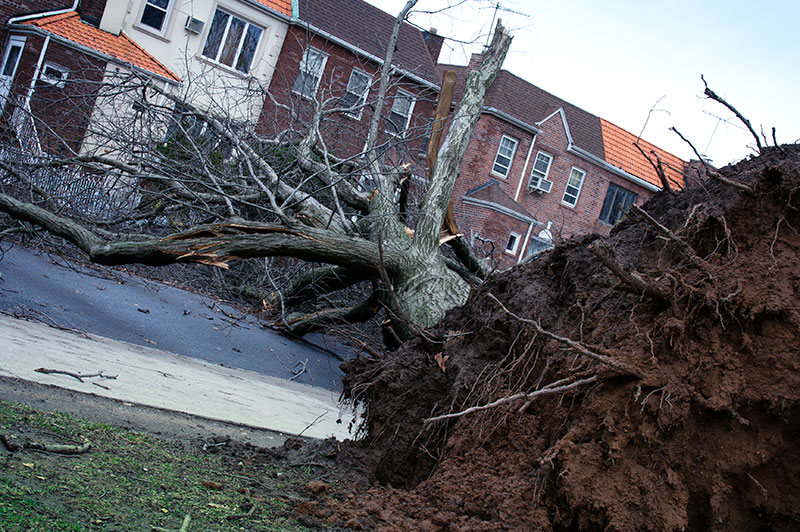
 Emergency Management311
Emergency Management311 Search all NYC.gov websites
Search all NYC.gov websites
Tornadoes

Though generally associated with the central United States, tornadoes occasionally occur in New York City. Such events can occur with little or no warning. Tornadoes are typically caused by powerful thunderstorms, or sometimes accompany tropical storms and hurricanes.
Know the Terms
- Tornado: a violently rotating column of air, usually pendant to a cumulonimbus, with circulation reaching the ground. It nearly always starts as a funnel cloud and may be accompanied by a loud roaring noise. On a local scale, it is the most destructive of all atmospheric phenomena.
- Tornado Watch: issued when conditions are favorable for the development of tornadoes in and close to the watch area. Their size can vary depending on the weather situation. They are usually issued for a duration of 4 to 8 hours. They normally are issued well in advance of the actual occurrence of severe weather.
- Tornado Warning: issued when a tornado is indicated by radar or sighted by storm spotters. They can be issued without a Tornado Watch already in effect. They are usually issued for a duration of approximately 30 minutes.
- Enhanced Fujita Scale: used to classify tornadoes and the damage they cause across the country. The Enhanced Fujita (EF) Scale measures the wind speeds and resultant damage of tornadoes based on 28 damage indicators and six classes of wind speeds.
- EF 0: wind speeds of 65 to 85 mph
- EF 1: wind speeds of 86 to 110 mph
- EF 2: wind speeds of 111 to 135 mph
- EF 3: wind speeds of 136 to 165 mph
- EF 4: wind speeds of 166 to 200 mph
- EF 5: wind speeds of 200 mph or more
What to Do to Prepare for a Tornado
- As part of your emergency plan, pick an area in your home to take shelter in the event of a tornado.
- Assemble an emergency supply kit.
- Notify NYC, the City of New York's official, free emergency communications program, will alert New Yorkers if there is an emergency in your area.
- Register for emergency notifications by get the free Notify NYC mobile application, visiting NYC.gov/notifynyc, contacting 311 (212-639-9675 for Video Relay Service, or TTY: 212-504-4115) or following @NotifyNYC on Twitter. Notify NYC messages are available through many formats, including email, text messages, telephone, the Notify NYC website, RSS, Twitter, and American Sign Language videos.
- Stay tuned to Notify NYC, your local radio and television stations for the latest storm information.
- Know the difference between a tornado watch and a tornado warning.
- Learn tornado danger signs:
- An approaching cloud of debris can mark the location of a tornado even if a funnel is not visible.
- Before a tornado hits, the wind may die down and the air may become very still.
- Tornadoes generally occur near the trailing edge of a thunderstorm. It is not uncommon to see clear, sunlit skies behind a tornado.
What to Do During a Tornado
- Go to your basement or the lowest point of your home. If an underground shelter is not available, move to a small interior room or hallway on the lowest floor and get under a sturdy piece of furniture. Put as many walls as possible between you and the outside.
- Stay away from windows.
- Get out of vehicles. Get indoors as quickly as possible.
- Be aware of flying debris.
- Do not try to outrun a tornado in your vehicle; exit the vehicle immediately for safe shelter.
- If you cannot find shelter, take cover in a ditch or other recessed area and cover your head with your hands. Do NOT take cover under an overpass or bridge.
- Avoid places with wide-span roofs, such as auditoriums, cafeterias, large hallways, or shopping malls.
What to Do After a Tornado
- Call 911 if you are in immediate danger.
- Watch out for fallen power lines and stay away from damaged areas.
- Stay tuned to Notify NYC.
- Tune in to local TV and radio for officials' announcements.
- Help injured or trapped persons; give first aid when appropriate.
- Do not try to move the seriously injured unless they are in immediate danger of further injury.
- If you smell gas, do not turn on any appliances or switches. This includes using telephones, flashlights, or a mobile phone.
- Clean up spilled medicines, bleaches, gasoline, or other flammable liquids immediately. Leave the building if you smell gas or chemical fumes.
- Take pictures of the damage to your home and its contents — for insurance purposes.
What the City Does
The City works closely with the National Weather Service to monitor severe weather threats that could affect the five boroughs. The City uses several forms of outreach to alert the public in an emergency, including Notify NYC, the City of New York's official emergency communications program.
If a tornado causes downed trees, downed power lines, and/or other emergencies, NYC Emergency Management will coordinate the response to these safety hazards with other City agencies, and notify the public to avoid dangerous areas or blocked roadways.
More Resources
- Are You Ready for a Tornado? (Red Cross)
- Tornado Fact Sheet (FEMA)


